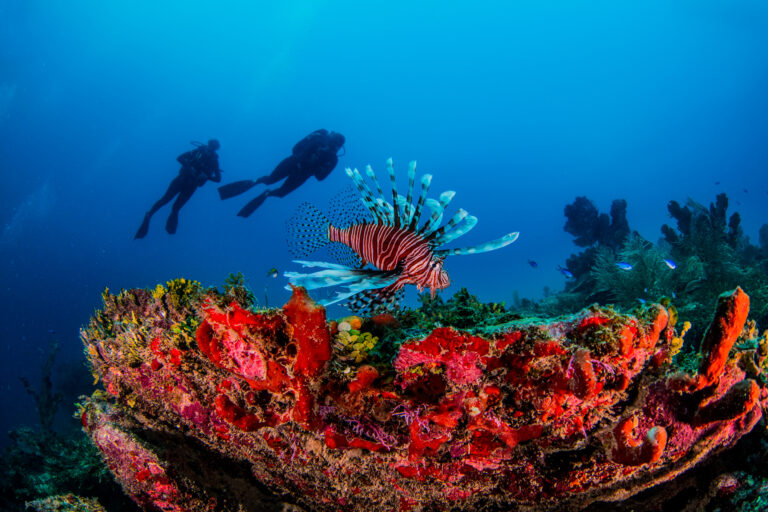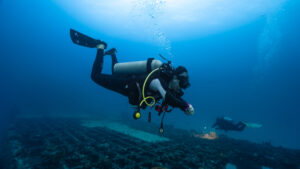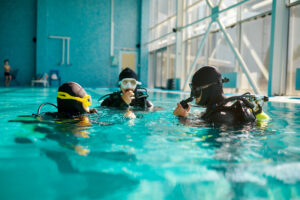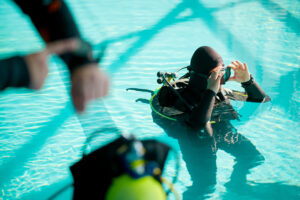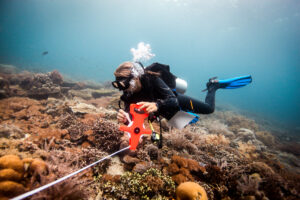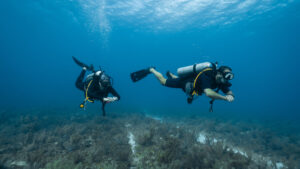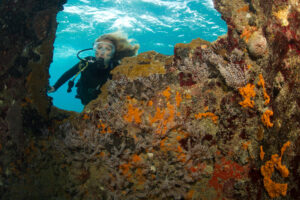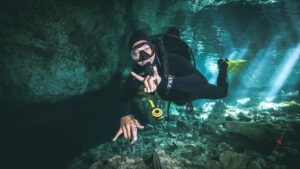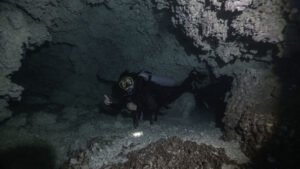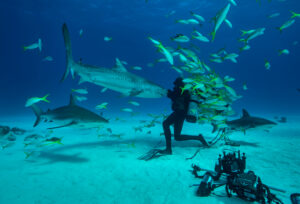What is Trimix?
Trimix is a specialized breathing gas mixture used by technical divers to safely reach greater depths than what is achievable with air or nitrox. Comprising oxygen, nitrogen, and helium, trimix helps mitigate the risks associated with deep diving, such as nitrogen narcosis and oxygen toxicity. By reducing the proportion of nitrogen and oxygen in the breathing mix, trimix allows divers to explore depths well beyond recreational limits while maintaining a safer physiological profile.
Historical Development
The use of helium in diving dates back to the early 20th century, initially driven by the need to solve the problems associated with deep-sea diving. The United States Navy began experimenting with helium-oxygen mixtures in the 1920s and 1930s to combat nitrogen narcosis and the limitations of oxygen toxicity at depth. These early experiments laid the groundwork for the development of trimix, although the mixtures used at the time did not include nitrogen.
By the 1960s and 1970s, the diving community started to recognize the potential benefits of trimix for civilian use. Technical diving pioneers such as Jacques Cousteau and the explorers involved in cave diving and deep wreck exploration began using helium-based mixtures to reach new depths safely. The increased understanding of decompression theory and advancements in dive computing further facilitated the adoption of trimix in the diving community.
In the 1990s, trimix became more widely accepted and utilized, especially with the advent of technical diving courses that specifically trained divers in the use of these gas mixtures. Organizations like the Professional Association of Diving Instructors (PADI) and Technical Diving International (TDI) developed training programs to educate divers on the safe use of trimix. These efforts significantly contributed to the broader acceptance and routine use of trimix in technical diving operations.
Physical and Chemical Properties
Trimix is composed of three primary gases: oxygen, nitrogen, and helium. Oxygen, essential for human respiration, typically makes up about 21% of the Earth’s atmosphere. In trimix, the oxygen percentage is adjusted to reduce the risk of oxygen toxicity at greater depths. Nitrogen, which constitutes approximately 78% of the Earth’s atmosphere, is included in trimix but in lower proportions to minimize nitrogen narcosis, a condition that impairs cognitive function at high pressures.
Helium, an inert gas, is added to replace a significant portion of nitrogen and oxygen in the mix. Helium’s primary advantage is its low narcotic effect, even under high pressure, making it an ideal component for deep diving. Additionally, helium has a higher thermal conductivity than other gases, which can help prevent the build-up of excess body heat during long decompression stops.
The behavior of these gases under pressure is a crucial consideration in their use. For example, the partial pressure of oxygen must be carefully controlled to avoid toxicity, particularly during long dives. Similarly, managing the proportions of nitrogen and helium helps to balance the effects of narcosis and decompression sickness, ensuring a safer and more controlled ascent for divers.
Preparation and Composition Variations
The preparation of trimix involves precise mixing of oxygen, nitrogen, and helium in specific ratios, tailored to the depth and duration of the dive. This process requires specialized equipment, including gas blending panels and analyzers to ensure the correct proportions are achieved. The accuracy of gas mixing is paramount, as even small deviations can significantly impact the safety and effectiveness of the breathing mix.
Trimix blends are categorized based on their specific gas ratios, commonly referred to as normoxic and hypoxic mixes. Normoxic trimix typically contains an oxygen percentage similar to that of air, making it suitable for dives up to approximately 60 meters (196.85 feet). Hypoxic trimix, on the other hand, has a reduced oxygen content and is used for deeper dives, often exceeding 60 meters, where the risk of oxygen toxicity becomes more pronounced.
The choice of trimix blend depends on various factors, including the planned dive depth, bottom time, and the diver’s experience level. For example, a dive to 100 meters (328.08 feet) might require a hypoxic blend with a lower oxygen percentage to ensure safety throughout the dive. Divers must also consider the type of diving they are undertaking, whether it is wreck exploration, cave diving, or open ocean diving, as these environments may present different challenges and risks.
Physiological Effects
The physiological effects of trimix on the human body are a critical aspect of its use in deep diving. Compared to air or nitrox, trimix significantly reduces the risk of nitrogen narcosis, a condition that can impair a diver’s cognitive and motor functions. By lowering the nitrogen content and replacing it with helium, divers can maintain clearer thinking and better motor control at greater depths, enhancing both safety and performance.
Oxygen toxicity is another major concern in deep diving. When using air or nitrox, the increased partial pressure of oxygen at depth can lead to central nervous system (CNS) toxicity, which can cause seizures and other serious complications. Trimix addresses this by reducing the oxygen fraction in the breathing gas, allowing divers to operate at depths where the partial pressure of oxygen remains within safe limits.
Helium, while beneficial in reducing narcosis, also has its own physiological considerations. It conducts heat more efficiently than nitrogen or oxygen, which can lead to increased heat loss for the diver. This effect necessitates the use of proper thermal protection, especially during extended dives or in cold water environments. Additionally, the high diffusivity of helium can lead to the phenomenon known as “helium bends” or decompression sickness, requiring careful planning and execution of decompression procedures.
Operational Considerations
Using trimix requires specialized training and certification, as the complexities of gas management, decompression planning, and emergency protocols differ significantly from those of air or nitrox diving. Divers must undergo rigorous training to understand the proper use of trimix, including how to calculate gas mixtures, plan dives, and manage potential risks.
Safety protocols are paramount when handling and using trimix. Divers must ensure their gas cylinders are correctly labeled and analyzed before each dive to verify the mix’s accuracy. Additionally, dive planning must account for the specific gas mix being used, with detailed decompression schedules to manage the gradual reduction of pressure and prevent decompression sickness.
Emergency procedures for trimix diving include managing potential oxygen toxicity incidents, dealing with nitrogen narcosis if the gas mix is not correctly prepared, and handling decompression sickness. Divers must be equipped with the knowledge and tools to respond effectively to these emergencies, including the use of backup gas supplies and emergency ascent protocols.
Applications in Scuba Diving
Trimix is used in a variety of technical diving scenarios, each with its own set of challenges and requirements. In wreck diving, trimix allows divers to explore sunken ships at depths that would be otherwise inaccessible with standard air or nitrox. The reduced narcosis and oxygen toxicity risks enable longer and safer bottom times, facilitating detailed exploration and documentation of these underwater sites.
Cave diving is another application where trimix proves invaluable. The confined and often complex environments of underwater caves require clear thinking and precise motor control, both of which are enhanced by the use of trimix. By mitigating the effects of nitrogen narcosis, divers can navigate these challenging environments with greater safety and efficiency.
Scientific and exploration missions also benefit from the use of trimix. Researchers studying deep-water ecosystems or geological formations rely on trimix to reach and study areas that are beyond the safe limits of recreational diving. These missions often involve extended bottom times and complex decompression schedules, making the reduced risks associated with trimix essential for success.
Advantages and Challenges
The primary advantage of using trimix in diving is its ability to significantly extend the depth and duration limits beyond those achievable with air or nitrox. This expanded range opens up new opportunities for exploration and research, providing access to underwater sites and environments that would otherwise be out of reach. Additionally, the reduced risk of nitrogen narcosis and oxygen toxicity enhances diver safety and performance at greater depths.
However, there are also challenges associated with the use of trimix. The cost and availability of helium can be significant limiting factors, as helium is more expensive and less readily available than other gases used in diving. Furthermore, the preparation and use of trimix require specialized training and equipment, adding to the overall complexity and expense of technical diving.
Another challenge is the increased thermal conductivity of helium, which can lead to greater heat loss and the need for enhanced thermal protection. Divers using trimix must be prepared for these conditions, ensuring they have the appropriate gear and clothing to maintain body temperature during extended dives.
Key Takeaways
Trimix is an essential breathing gas for technical divers seeking to safely explore deeper underwater environments. Its unique composition of oxygen, nitrogen, and helium reduces the risks of nitrogen narcosis and oxygen toxicity, allowing for greater depth and extended bottom times. While the use of trimix presents certain challenges, including cost, availability, and the need for specialized training, its advantages make it a vital tool for advanced diving operations. Proper training and adherence to safety protocols are crucial for maximizing the benefits and minimizing the risks associated with trimix diving.

